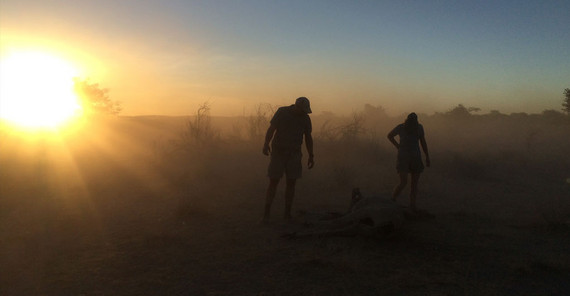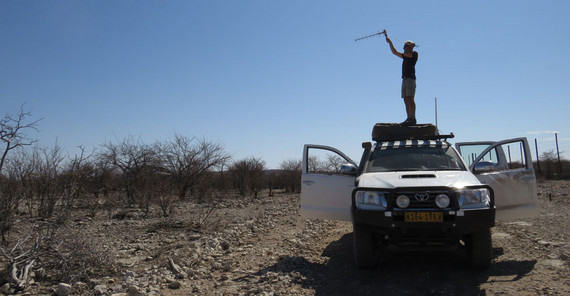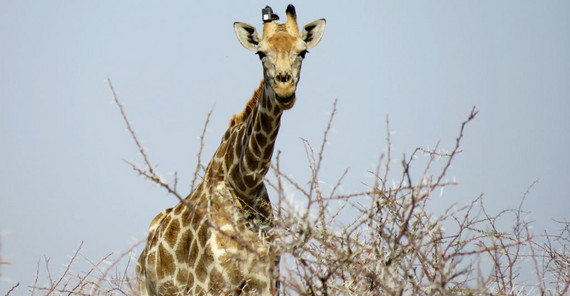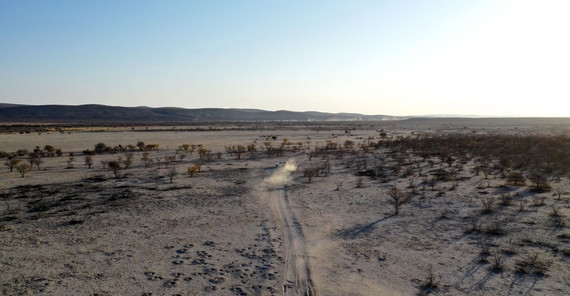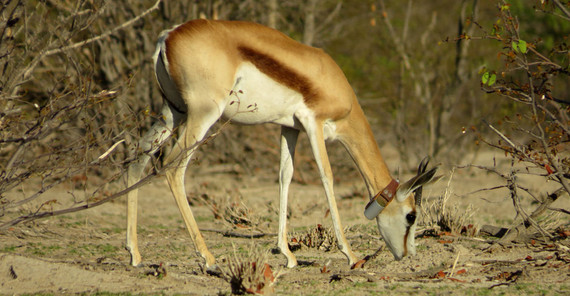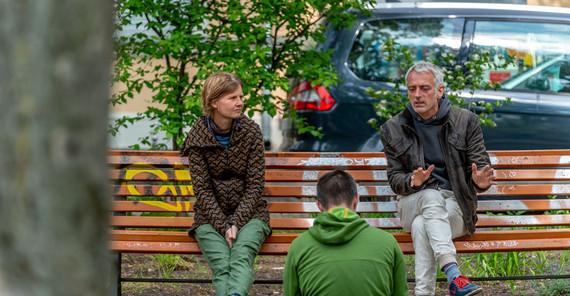The same problem exists in many places in Africa: The intensive use of large areas as pasture for commercial animal husbandry is damaging the land. It degrades, as researchers say. Grass and trees that previously dominated the savanna are being replaced by thorny bushes and shrubs. As a result, the land is not only lost for livestock farming but it is also degraded ecologically. Potsdam researchers had already been looking for the causes of this development in the OPTIMASS project since 2014 - as well as for ways to stop or, at best, reverse it. “The extensive land degradation in Namibia has brought farmers and researchers together,” explains Dr. Niels Blaum, who led OPTIMASS together with Prof. Florian Jeltsch. When the grassland becomes overgrown with bushes, the farmers will lose their means of existence: Their animals can no longer find enough feed. “That is only the obvious loss,” emphasizes biologist Katja Geißler, who coordinated the research project and was regularly on site in Namibia. But the decline in grassland has additional consequences. Where the sward no longer protects the soil, it erodes more easily. The rain flows off the surface and less seeps into the ground. Groundwater balance, nutrient cycles, and species composition change. The entire ecosystem is affected.
Can wildlife save the savanna?
When the OPTIMASS project came to an end in 2018, politically motivated changes began to create completely new conditions. The concept of “communal conservancies” is one fundamental aspect. Where such "conservancies" are set up, it grants local communities sovereignty over their habitat, which also includes the rights to the use of land and wildlife. At the same time, people are responsible for the protection of the flora and fauna, thus making a significant contribution to the preservation of biodiversity. This has not only recognized local people and strengthened their rights but also successfully contained illegal poaching. “Poachers became gamekeepers in many places,” Blaum says. “They usually had the best knowledge about wild animals in their region anyway.” Today, almost 40% of Namibia’s land surface consists of “conservancies”, of which about 25% are “communal conservancies”, i.e. state-owned land, and 15% private “freehold conservancies”.
In addition, 10% percent of the land are national parks and private reserves. They differ greatly, of course, in the way they use land and animals. The primary purpose of the national parks is to protect flora and fauna, while the “communal conservancies” only use resources for their own subsistence. “Freehold conservancies”, on the other hand, are associations of private farms for the protection of wildlife. They keep wild animals for commercial game meat production. Last but not least, there are “conservancies” and private wildlife farms that specialize in hunting or photo tourism and settle the respective animals. It is still completely unclear what effects it has on the savanna ecosystem that, as a result, more wild than farm animals are being kept, says Blaum.
That is why the Potsdam researchers launched a follow-up project together with their German and Namibian partners: ORYCS. Its goal is to investigate whether wildlife-based management is suitable for the sustainable use of savannas. “So far there haven’t been any studies on whether it is better than the previously dominant livestock husbandry,” says Blaum. “For this reason we analyze the different types of use and how they can be optimized.” How does settling wild animals, quite often in different composition, affect vegetation? How do vegetation and water balance develop in areas with large springbok, kudu, or eland populations? How is climate change affecting the interaction of these factors? Can the local population in particular ensure a stable ecological balance? The researchers have to answer these diverse questions to understand this complex system. That is why the team includes researchers from a wide range of disciplines such as wildlife ecology, vegetation ecology, hydrogeology, geological remote sensing, and social ecology.
With GPS-transmitters and drones
The Potsdam researchers coordinate the whole project, which is headed by Niels Blaum. They also work on four of six work packages. During field observations, they collect data together with the Namibian partners. They provide animals and plants with transmitters, measure water fluxes and biomass in predefined areas, conduct experiments on different vegetation systems and register the investigated areas with the most modern remote sensing technology.
In one subproject, Blaum himself investigates where exactly the wild animals live and move. “We are interested in how the most important herbivores in the parks influence their vegetation,” says the researcher. To this end, the ecologists record and analyze the movements of wildlife over a longer period of time - and sometimes very large distances. One of the central study areas covers 70,000 hectares alone. To be able to follow the animals, they are caught and equipped with transmitters. These have GPS and acceleration sensors. This state-of-the-art technology opens up completely new possibilities for the research area “Movement Ecology”. The sensors not only locate the animals with an accuracy of a few meters and record where they stay for a longer time. “We can even see what exactly they are doing in the respective place: whether they are fleeing, walking slowly or standing, how they hold their heads and possibly eat and drink,” says Blaum. Ultimately, the researchers want to find out how wild animals interact with vegetation. To this end, Blaum and his team want to radio-mark a total of 50 animals of three different species that are at home in the conservancies they investigate: springbok, kudu, and eland, the largest antelope species in Africa. The researchers assume that wild animals are better adapted to climatic conditions and savanna vegetation than farm livestock. “The wild animals feed on bushes and trees, even the new seedlings. Cattle don’t do that at all,” says Blaum. “Because many bushes are 'armed' with thorns or store poorly digestible substances in their leaves.” Wildlife is therefore more likely to help limit or even reduce bush encroachment.
Since the wild animals in the conservancies are settled and kept by people, ORYCS is intended to clarify who is “getting on well” with whom. “The grazing pressure of wildlife also influences the architecture of trees and thus possibly the entire water balance of the areas,” explains Dr. Katja Geißler. The ecologist deals with water fluxes in the savanna. She and her colleagues combine various research methods to reconstruct this complex system. They register the vegetation in selected typical areas. They do this together with colleagues like the Potsdam geoscientist Prof. Bodo Bookhagen, who contributes his expertise in “eco-hydro-geomorphic remote sensing”. By analyzing satellite and drone images of the region, Geißler and her colleagues scale the identified biomass to the entire investigated area. They record the soil moisture and provide selected trees with sensors that show differences in water fluxes. Some of the examined trees are artificially defoliated to be able to measure grazing by wild animals. “By comparing trees with different degrees of grazing, we can identify the influence of the grazing pressure on the water balance of the trees and the water fluxes,” she says. All measurements are ultimately brought together to map the “scale-crossing water fluxes” and to be able to combine them with the studies on the diversity of plant species. For this “eco-hydrological modeling of plant diversity”, the Potsdam researchers are collaborating with colleagues from Freie Universität Berlin headed by Prof. Britta Tietjen.
All disciplines for one goal
All data and findings will ultimately flow into a scenario-based wildlife model that is being developed under the direction of Prof. Florian Jeltsch and Dr. Dirk Lohmann. It is intended to help make wildlife-based management both successful and environmentally friendly. “If we understand how the land surface is used, what effects the distribution of water, food, and predation pressure have, we will be able to develop recommendations for sustainable wildlife-based management.” Which animal and plant species fit together? How big can the populations be? How do the parks need to be designed so that the animals find optimal living conditions? “For example, the question of where to create watering places has an enormous impact on the parks,” explains Blaum. “Because the wild animals follow the water - and feed where they drink. Animals, plants, and water balance are inextricably linked and constantly influence each other.”
To ensure that the project results effectively help and actually reach the stakeholders in Namibia, the researchers work closely with farmers, park administrations, village communities, ministries, and tourism associations right from the beginning. The needs, interests, and demands of the people who live and work with wildlife sometimes diverge widely, as Blaum explains. “The pressure experienced by farmers is very different from park operators who specialize in photo safaris. While some keep large herds of antelopes, others have to ensure that certain popular animal species get along in their parks and find suitable habitats.” The Institute for Socio-Ecological Research (ISOE) is committed to identifying and incorporating into the project the complex motives of the Namibian research and above all practice partners but also the valuable knowledge of the indigenous and local population. The institute, based in Frankfurt/ Main, works on moderating the conflict-prone challenges that arise from wildlife-based management.
Coronavirus as an inhibiting factor
The researchers were unable, however, to foresee a problem with global dimensions when they designed their concept: the Coronavirus pandemic. In early March 2020, Blaum and his colleagues, PhD students and students left for Namibia to collect large-scale data in the field over a period of three months following a joint summer school. “Unfortunately, we had to terminate our research stay after only three weeks,” says Blaum. “Air traffic between Germany and Namibia and some other countries was suspended as of March 16. Schools were also closed in Namibia. Eleven days later, there was another level of lockdown. Travel between regions within Namibia was prohibited. In the end, we were very happy to arrive in Windhoek on time and to be able to fly to Frankfurt/ Main on a government flight on March 29.”
The fact that they had to interrupt their fieldwork has devastating consequences for the ORYCS researchers. Only a fraction of the animals could be radio-marked, and the examination of the vegetation also had to be stopped soon after it was started. Some measuring stations are equipped with rechargeable batteries and can collect data for a few weeks. “But we have virtually lost the field observation phase for this year,” says Blaum. They are already discussing with the project sponsor how to solve this problem. The coming weeks and months will show whether deadlines can be extended and additional finances can be provided. What is needed now is flexibility, imagination, and many good ideas. The interruption also has dramatic consequences for those students and doctoral candidates who depend on the project data for their theses. “We’re also trying to find solutions for that, but, of course, work will be difficult without any data.” That is why Blaum and his colleagues want to restart data collection with the help of their Namibian colleagues as soon as the local situation will allow it. “Our models can only become good enough with the data from fieldwork so that they can be used to predict how wildlife management will help flora, fauna, and the people even under changing climatic conditions.”
The Researchers
PD Dr. Niels Blaum studied biology in Nice and Frankfurt/Main. Since 2004, he has been research assistant in the Plant Ecology and Nature Conservation Group of the University of Potsdam.
Mail: blaumuuni-potsdampde
Dr. Katja Geißler studied biology in Berlin and Aberystwyth. Since 2009, she has been research assistant in the Plant Ecology and Nature Conservation Group of the University of Potsdam.
Mail: kgeissleuuni-potsdampde
The Project
ORYCS – Option for sustainable land use adaptations in savanna systems: Chances and risks of emerging wildlife-based management strategies under regional and global change
Participants: University Potsdam (coordinator), Namibia University of Science and Technology, Freie Universität Berlin, University of Namibia, Institute for Social-Ecological Research, Ministry of Environment and Tourism Namibia
Duration: 2019–2021
Funding: Federal Ministry of Education and Research (BMBF)
This text was published in the university magazine Portal Wissen - Two 2020 „Health“.


